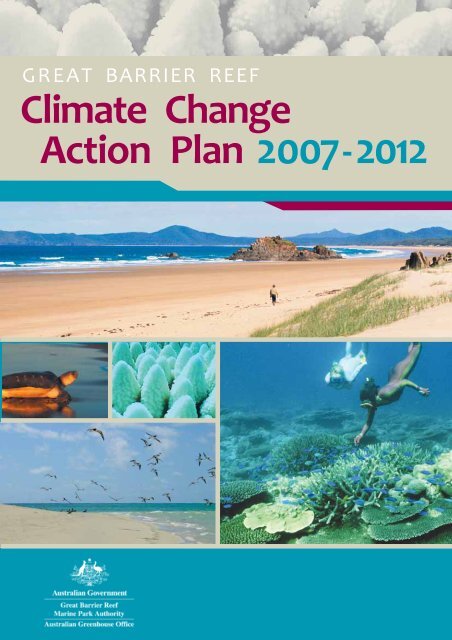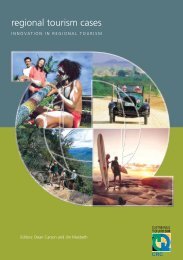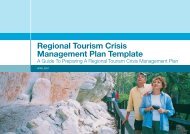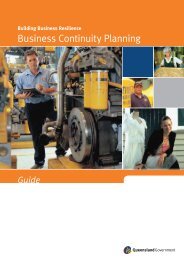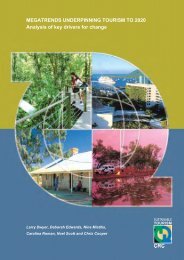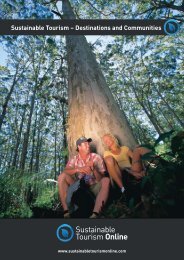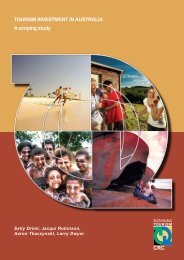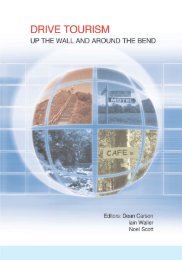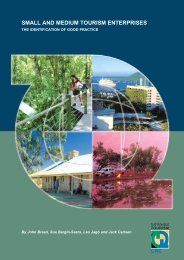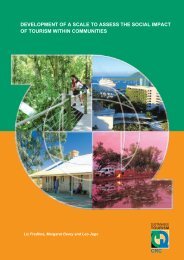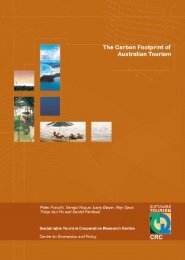Climate Change Action Plan - Great Barrier Reef Marine Park Authority
Climate Change Action Plan - Great Barrier Reef Marine Park Authority
Climate Change Action Plan - Great Barrier Reef Marine Park Authority
Create successful ePaper yourself
Turn your PDF publications into a flip-book with our unique Google optimized e-Paper software.
GREAT BARRIER REEF<br />
<strong>Climate</strong> <strong>Change</strong><br />
<strong>Action</strong> <strong>Plan</strong><br />
2007 2012
GREAT BARRIER REEF<br />
<strong>Climate</strong> <strong>Change</strong><br />
<strong>Action</strong> <strong>Plan</strong><br />
2007 2012
This publication has been made possible in part by funding from the Australian Greenhouse Office, in<br />
the Department of the Environment and Water Resources.<br />
Published by:<br />
<strong>Great</strong> <strong>Barrier</strong> <strong>Reef</strong> <strong>Marine</strong> <strong>Park</strong> <strong>Authority</strong>, Townsville, Australia<br />
Copyright: © Commonwealth of Australia 2007<br />
Reproduction of this publication for educational or other non-commercial purposes is authorised<br />
without prior written permission from the copyright holder provided the source is fully acknowledged.<br />
Reproduction of this publication for resale or other commercial purposes is prohibited without prior<br />
written permission of the copyright holder.<br />
<strong>Great</strong> <strong>Barrier</strong> <strong>Reef</strong> <strong>Marine</strong> <strong>Park</strong> <strong>Authority</strong>.<br />
<strong>Great</strong> <strong>Barrier</strong> <strong>Reef</strong> climate change action plan 2007-2012.<br />
ISBN 9781876945626 (web).<br />
1. Global warming. 2. Climatic changes. 3. Greenhouse<br />
gases. 4. <strong>Great</strong> <strong>Barrier</strong> <strong>Reef</strong> <strong>Marine</strong> <strong>Park</strong> (Qld.). I. Title.<br />
363.7387<br />
Layout: RTM Design<br />
Please cite this publication as:<br />
<strong>Great</strong> <strong>Barrier</strong> <strong>Reef</strong> <strong>Marine</strong> <strong>Park</strong> <strong>Authority</strong> (2007) <strong>Great</strong> <strong>Barrier</strong> <strong>Reef</strong> <strong>Climate</strong> <strong>Change</strong> <strong>Action</strong> <strong>Plan</strong><br />
2007 – 2011<br />
Available from: <strong>Great</strong> <strong>Barrier</strong> <strong>Reef</strong> <strong>Marine</strong> <strong>Park</strong> <strong>Authority</strong><br />
2–68 Flinders St, PO Box 1379, Townsville, Qld 4810, Australia<br />
Tel: +61 7 4750 0700, Fax: +61 7 4772 6093<br />
Email: info@gbrmpa.gov.au<br />
Also available from the web: http://www.gbrmpa.gov.au/<br />
This is a climate neutral publication. All greenhouse gases generated in the<br />
production have been offset by funding clean energy projects.<br />
Visit www.climatefriendly.com for further information
Contents<br />
Minister’s Foreword …………………………………......................................................................................…………… 2<br />
Background ………………………………………...............................................................................................…………… 3<br />
Objective 1: Targeted Science …………….....................................................................................………………… 6<br />
Objective 2: A Resilient <strong>Great</strong> <strong>Barrier</strong> <strong>Reef</strong> Ecosystem ……................................................…………….. 7<br />
Objective 3: Adaption of Industries & Communities …............................................................................… 8<br />
Objective 4: Reduced <strong>Climate</strong> Footprints ………………................................................................................… 9<br />
Further Information …………………………….............................................................................................……………10<br />
<strong>Great</strong> <strong>Barrier</strong> <strong>Reef</strong> <strong>Climate</strong> <strong>Change</strong> <strong>Action</strong> <strong>Plan</strong> 2007–2012<br />
1
Minister s Foreword<br />
The <strong>Great</strong> <strong>Barrier</strong> <strong>Reef</strong> holds a very special place in the hearts and minds of Australians and its<br />
international significance is enshrined in its status as a World Heritage Area. It supports a wealth of<br />
recreational opportunities, thousands of jobs, and industries worth $6.9 billion dollars annually.<br />
However, coral reefs are highly vulnerable to the effects of climate change, and the <strong>Great</strong> <strong>Barrier</strong><br />
<strong>Reef</strong> is not immune from this threat.<br />
The Australian Government is already recognised internationally as a leader in protecting coral reefs<br />
from the impacts of climate change. Current strategies to maintain and restore resilience to the <strong>Great</strong><br />
<strong>Barrier</strong> <strong>Reef</strong> include the Zoning <strong>Plan</strong> and the <strong>Reef</strong> Water Quality Protection <strong>Plan</strong>. The <strong>Great</strong> <strong>Barrier</strong><br />
<strong>Reef</strong> <strong>Climate</strong> <strong>Change</strong> <strong>Action</strong> <strong>Plan</strong> establishes a program of practical actions that will complement<br />
these internationally lauded measures and build the long-term resilience of the <strong>Great</strong> <strong>Barrier</strong> <strong>Reef</strong> to<br />
climate change.<br />
The book <strong>Climate</strong> change and the <strong>Great</strong> <strong>Barrier</strong> <strong>Reef</strong>: A Vulnerability Assessment, provides the<br />
foundation for the <strong>Great</strong> <strong>Barrier</strong> <strong>Reef</strong> <strong>Climate</strong> <strong>Change</strong> <strong>Action</strong> <strong>Plan</strong>. This <strong>Action</strong> <strong>Plan</strong> identifies specific<br />
measures to enhance resilience of the <strong>Great</strong> <strong>Barrier</strong> <strong>Reef</strong> ecosystem and support adaptation by<br />
regional communities and industries that depend on it.<br />
The Government has allocated almost $9 million over the next five years to implement the <strong>Action</strong><br />
<strong>Plan</strong>. This is in addition to a considerable investment in research through the <strong>Marine</strong> and Tropical<br />
Science Research Facility and day-to-day management of the <strong>Great</strong> <strong>Barrier</strong> <strong>Reef</strong> <strong>Marine</strong> <strong>Park</strong>.<br />
Through these efforts, the Australian Government will help sustain the values that make the <strong>Great</strong><br />
<strong>Barrier</strong> <strong>Reef</strong> special.<br />
The Hon Malcolm Turnbull MP<br />
Minister for the Environment and Water Resources<br />
2 <strong>Great</strong> <strong>Barrier</strong> <strong>Reef</strong> <strong>Climate</strong> <strong>Change</strong> <strong>Action</strong> <strong>Plan</strong> 2007–2012
Background<br />
<strong>Climate</strong> change is now recognised as the<br />
greatest long-term threat to the <strong>Great</strong><br />
<strong>Barrier</strong> <strong>Reef</strong>.<br />
The <strong>Great</strong> <strong>Barrier</strong> <strong>Reef</strong> is internationally renowned as<br />
a place of great beauty and ecological significance<br />
and is protected as a <strong>Marine</strong> <strong>Park</strong> and a World<br />
Heritage Area. It is of immense social, economic and<br />
cultural value to the people of Australia.<br />
While the <strong>Great</strong> <strong>Barrier</strong> <strong>Reef</strong> is recognised as one of<br />
the best-managed coral reef systems in the world,<br />
climate-related events have already caused<br />
significant impacts. Coral bleaching affected over<br />
50% of reefs in both 1998 and 2002, and seabird<br />
nesting failures were observed in 2002 and 2005.<br />
These are just the first of many anticipated impacts of<br />
climate change on the <strong>Reef</strong>. However, climate<br />
change is not the only threat to the <strong>Reef</strong>; rather, it’s<br />
effects will interact with other pressures such as<br />
degraded water quality and unsustainable fishing.<br />
Two major factors will dictate the future health of the<br />
<strong>Reef</strong>: the rate and extent of climate change, and the<br />
resilience of the <strong>Reef</strong> ecosystem to climate change.<br />
While the bigger issue of climate change mitigation is<br />
a matter for international policy, the resilience of the<br />
<strong>Reef</strong> is under the influence of local management<br />
strategies.<br />
To secure the future of the <strong>Reef</strong> it is essential for<br />
agencies responsible for managing the <strong>Marine</strong> <strong>Park</strong><br />
and its adjacent catchment to do everything possible<br />
to restore and maintain the resilience of the<br />
ecosystem. It is critical that coordinated actions are<br />
taken to protect biodiversity, improve water quality<br />
and ensure sustainable fishing.<br />
Resilience-based management of the <strong>Reef</strong> is core<br />
business for the <strong>Great</strong> <strong>Barrier</strong> <strong>Reef</strong> <strong>Marine</strong> <strong>Park</strong><br />
<strong>Authority</strong>. Major resilience-building actions already<br />
underway include the <strong>Reef</strong> Water Quality Protection<br />
<strong>Plan</strong> and the <strong>Great</strong> <strong>Barrier</strong> <strong>Reef</strong> <strong>Marine</strong> <strong>Park</strong> Zoning<br />
<strong>Plan</strong>. The emergence of climate change makes these<br />
efforts even more important, while also presenting<br />
new challenges and demanding further action.<br />
Without such action, the <strong>Reef</strong> faces a bleak future<br />
under almost all possible future climate scenarios. By<br />
taking action, the Australian Government will continue<br />
to provide global leadership in the management of<br />
coral reef ecosystems facing the threat of climate<br />
change.<br />
This <strong>Action</strong> <strong>Plan</strong> outlines a way forward for the<br />
Australian Government to comprehensively<br />
act to maximise the resilience of the <strong>Reef</strong>.<br />
<strong>Great</strong> <strong>Barrier</strong> <strong>Reef</strong> <strong>Climate</strong> <strong>Change</strong> <strong>Action</strong> <strong>Plan</strong> 2007–2012<br />
3
<strong>Climate</strong> change is affecting coral<br />
reefs<br />
<strong>Climate</strong> change is now acknowledged as one of the<br />
most serious threats to the long-term health of coral<br />
reefs. Already, in many places around the world such<br />
as the Maldives, Seychelles and Palau, coral<br />
bleaching has effectively destroyed over 50% of reefs.<br />
This loss of corals, triggered by unusually high sea<br />
temperatures, has far-reaching implications for reef<br />
ecosystems. Corals provide the ecological<br />
foundations that underpin enormous biodiversity and<br />
productivity, and provide food and income to hundreds<br />
of millions of people throughout the tropical world.<br />
There will also be a range of other effects of climate<br />
change on reef ecosystems, many of which may be<br />
equally destructive but are only just beginning to be<br />
understood.<br />
The implications of climate change<br />
are far reaching<br />
The vulnerability of other parts of the GBR ecosystem<br />
to climate change is also becoming apparent. Mass<br />
die-offs of seabird chicks have been recorded during<br />
periods of unusually high sea temperatures. These<br />
nesting failures are now known to be due to<br />
provisioning failure, resulting when parent birds have<br />
difficulty obtaining prey fish because of changes in the<br />
location of productivity zones. Sea turtles are also at<br />
risk. The sex ratio of turtle hatchlings is temperaturedependent,<br />
and warming conditions could see a<br />
significant bias toward females in future populations.<br />
Commercially important species, such as many fish<br />
and prawns, rely on corals, seagrasses or mangroves<br />
for some part of their life cycle. These important<br />
habitats are projected to decline under climate change,<br />
suggesting that many fisheries may also be<br />
significantly affected. These and many other potential<br />
effects of climate change will translate to significant<br />
issues for the regional communities and industries that<br />
depend on a healthy GBR. This includes the GBR<br />
tourism industry that as part of regional tourism<br />
contributes $6 billion to the national economy 2 per<br />
annum.<br />
The <strong>Great</strong> <strong>Barrier</strong> <strong>Reef</strong> is at risk<br />
The <strong>Great</strong> <strong>Barrier</strong> <strong>Reef</strong> (GBR) is not immune from this<br />
threat. It is already showing observable signs of its<br />
vulnerability, in the form of mass coral bleaching<br />
events in 1998 and 2002. In each of these years, more<br />
than 50% of the reef was affected by bleaching.<br />
Fortunately, most corals survived the high<br />
temperatures, yet approximately 5% of reefs suffered<br />
lasting damage. A more localised bleaching event<br />
occurred in 2006, leading to the death of 40% of corals<br />
around the Keppel Islands, an important group of<br />
inshore reefs off Rockhampton. An analysis of climate<br />
projections 1 indicates that coral bleaching events are<br />
expected to become more frequent and severe over<br />
coming decades, even under optimistic scenarios.<br />
Other parts of the system are also at risk, such as<br />
plankton, seagrass, marine turtles, seabirds,<br />
mangroves and fish.<br />
1 Intergovernmental Panel on <strong>Climate</strong> <strong>Change</strong>, Summary for Policy Makers (2007)<br />
2 Access Economics (2007) Measuring the Economic and Financial Value of the<br />
<strong>Great</strong> <strong>Barrier</strong> <strong>Reef</strong> <strong>Marine</strong> <strong>Park</strong> 2005-2006, Canberra<br />
4 <strong>Great</strong> <strong>Barrier</strong> <strong>Reef</strong> <strong>Climate</strong> <strong>Change</strong> <strong>Action</strong> <strong>Plan</strong> 2007–2012
Management actions can increase<br />
the resilience of the GBR to climate<br />
change<br />
The threat posed by climate change to the GBR has<br />
been comprehensively evaluated through an expertbased<br />
vulnerability assessment. The outcomes of this<br />
process are to be published in the report: <strong>Climate</strong><br />
change and the <strong>Great</strong> <strong>Barrier</strong> <strong>Reef</strong>, due for release in<br />
May 2007. The <strong>Great</strong> <strong>Barrier</strong> <strong>Reef</strong> <strong>Marine</strong> <strong>Park</strong><br />
<strong>Authority</strong> (GBRMPA) and the Australian Greenhouse<br />
Office (AGO) facilitated this process to inform<br />
adaptation actions in response to climate change. The<br />
vulnerability assessment makes it clear that the GBR<br />
will experience further deterioration over coming<br />
decades as a result of climate change. The extent of<br />
future impacts, and the implications for the condition of<br />
the GBR, will depend on the rate and magnitude of<br />
climate change. The report also identifies that<br />
enhancing resilience minimises impacts on the<br />
ecosystem and the goods and services it provides<br />
Australia. The detailed assessment, including<br />
contributions from 86 leading coral reef and climate<br />
change scientists, provides important guidance on<br />
ways to increase the resilience of the GBR socioecological<br />
system to climate change. These insights<br />
are the basis for the GBR <strong>Climate</strong> <strong>Change</strong> <strong>Action</strong> <strong>Plan</strong>.<br />
A climate change action plan for<br />
the <strong>Great</strong> <strong>Barrier</strong> <strong>Reef</strong><br />
The GBR <strong>Climate</strong> <strong>Change</strong> <strong>Action</strong> <strong>Plan</strong> outlines a<br />
coordinated response to the threat of climate change<br />
for the GBR. It identifies strategies for direct actions<br />
and partnerships that will increase the resilience of the<br />
GBR to climate change. This will help minimise<br />
impacts on GBR industries such as tourism,<br />
commercial and recreational fishing that together<br />
contribute $6.9 billion to the national economy per<br />
annum 2 . The action plan is underpinned by the<br />
knowledge, partnerships and adaptation measures<br />
that have been established in the first three years of<br />
the GBR <strong>Climate</strong> <strong>Change</strong> Response Program, funded<br />
by the Australian Government through the AGO and<br />
the GBRMPA.<br />
Built on well-established resilience principles, it<br />
outlines a five year program of actions that GBR<br />
managers can take, in collaboration with stakeholders<br />
and other partners, to minimise the damage caused by<br />
climate change. The action plan is designed to<br />
coordinate with other relevant science and adaptation<br />
initiatives, including the National <strong>Climate</strong> <strong>Change</strong><br />
Adaptation Framework and research programs funded<br />
by the <strong>Marine</strong> and Tropical Sciences Research<br />
Science Facility (MTSRF) and the Australian Research<br />
Council. The action plan also complements climate<br />
change response strategies of the Queensland<br />
government and the GBR marine tourism industry. The<br />
action plan is organised around four objectives:<br />
targeted science, a resilient GBR ecosystem,<br />
adaptation of industries and regional communities, and<br />
reduced climate footprints.<br />
<strong>Great</strong> <strong>Barrier</strong> <strong>Reef</strong> <strong>Climate</strong> <strong>Change</strong> <strong>Action</strong> <strong>Plan</strong> 2007–2012<br />
5
Objective 1: Targeted science<br />
Robust information is the foundation for actions that<br />
are effective in reducing climate change<br />
vulnerability, while also avoiding unnecessary<br />
impacts on GBR stakeholders. This objective aims<br />
to provide critical knowledge needs for improving<br />
the resilience of the GBR to climate change, and for<br />
helping reef-based industries and regional<br />
communities to adapt to unavoidable impacts.<br />
The publication <strong>Climate</strong> <strong>Change</strong> and the <strong>Great</strong><br />
<strong>Barrier</strong> <strong>Reef</strong>, to be published as the key output of<br />
the GBR vulnerability assessment, provides a<br />
comprehensive synthesis of the state of scientific<br />
knowledge. It is the foundation for this action plan<br />
and highlights the significant gaps in knowledge<br />
necessary to assess risk and develop effective<br />
adaptation strategies. The research-related<br />
activities are complementary to projects supported<br />
by the MTSRF and Australian Research Council<br />
Linkage project scheme.<br />
Key strategies to understand climate change<br />
implications for the GBR are:<br />
1.1 Address critical knowledge gaps about<br />
climate change impacts on the GBR:<br />
• Partner with research institutions and<br />
coordinate research projects that target<br />
species vulnerable to climate change (eg<br />
corals, fishes, crustaceans, plankton, marine<br />
turtles, seabirds and seagrass) to optimise<br />
effectiveness of resilience-based<br />
management.<br />
• Map areas of high and low resilience to<br />
prioritise investment of management effort (eg<br />
identify and protect refugia for thermally<br />
tolerant coral species that will provide genetic<br />
stock for recovery).<br />
• Assess synergies between climate and nonclimate<br />
stressors on critical processes (such<br />
as productivity, connectivity, calcification and<br />
recovery potential) and prepare reports that<br />
will be the basis for revising management<br />
policies and targets.<br />
1.2 Identify thresholds, improve monitoring and<br />
predictions, and evaluate strategies, including:<br />
• Identify thresholds beyond which climate change<br />
causes irreversible damage to vulnerable species<br />
(eg sharks, marine turtles, seabirds, corals, fishes<br />
and plankton), habitats (eg seagrass, mangroves<br />
and pelagic) and processes (eg productivity and<br />
connectivity).<br />
• Work with partners to develop improved tools (eg<br />
operational remote sensing products, improved<br />
regional projections) for predicting, measuring and<br />
monitoring effects of climate change on vulnerable<br />
species (eg corals, marine turtles, seabirds, fishes<br />
and plankton).<br />
• Evaluate resilience strategies, such as the <strong>Reef</strong> Water<br />
Quality Protection <strong>Plan</strong> and Zoning <strong>Plan</strong>, to optimise<br />
their effectiveness in the context of climate change.<br />
1.3 Translate information into active management<br />
responses, including:<br />
• Coordinate and synthesise emerging scientific<br />
knowledge to underpin effective management decisions.<br />
• Use cost-benefit analyses to select management<br />
responses that maximise ecological resilience while<br />
minimising social and economic costs.<br />
• Partner with stakeholder groups, such as the tourism<br />
industry, to understand climate change implications,<br />
reduce climate footprint, and prepare adaptation plans.<br />
6 <strong>Great</strong> <strong>Barrier</strong> <strong>Reef</strong> <strong>Climate</strong> <strong>Change</strong> <strong>Action</strong> <strong>Plan</strong> 2007–2012
Objective 2: A resilient <strong>Great</strong> <strong>Barrier</strong> <strong>Reef</strong><br />
ecosystem<br />
The condition of the GBR ecosystem is predicted to<br />
decline over coming decades as the climate continues<br />
to change. The extent of this decline is a function of the<br />
rate and extent of climate change and the <strong>Reef</strong>’s<br />
resilience to this change. Significantly, the resilience of<br />
reefs is reduced by other stresses such as degraded<br />
water quality, fishing and loss of biological diversity.<br />
Knowledge of the interactions between climate and<br />
other stresses helps identify actions that can restore<br />
and maintain resilience, and thereby minimise impacts<br />
of climate change on the GBR ecosystem. This<br />
objective builds on emerging knowledge of resilience<br />
and of the risks posed by climate change and other<br />
stresses. The actions in this objective aim to reduce<br />
stresses on the ecosystem, facilitate natural<br />
adaptation and minimise ecological impacts.<br />
2.1 Maximise resilience of the GBR ecosystem to<br />
climate change, including:<br />
• Identify the main water quality threats<br />
(eg contaminant hotspots) to resilience as<br />
a basis for targeting management efforts.<br />
• Identify and protect transition or alternative<br />
habitats that will provide for shifts in distribution<br />
and abundance of species and habitats (eg turtle<br />
nesting, seabird breeding and productivity zones)<br />
affected by climate change.<br />
• Assess sustainability of fishing practices to<br />
ensure protection of habitat and key functional<br />
groups of plants and animals (for example<br />
herbivores) as a strategy for building resilience.<br />
• Protect species and habitats that are highly<br />
vulnerable to climate change (eg corals, marine<br />
turtles, seabirds, fish and mangroves) from nonclimate<br />
pressures (eg physical damage, human<br />
disturbance or coastal development).<br />
2.2 Adapt existing management to incorporate<br />
climate change considerations, including:<br />
• Consider expected climate change impacts whilst<br />
developing new water quality targets, ecosystem<br />
health guidelines and other management<br />
guidelines (eg Coastal Land Use Guidelines).<br />
• Ensure information on the vulnerability of species<br />
and habitats is incorporated into registers of<br />
threatened and endangered species.<br />
• Work with state fisheries management agencies<br />
to evaluate risks of climate change for<br />
sustainability of GBR fish populations and<br />
fisheries, which can be built into management<br />
plans.<br />
2.3 Minimise climate change impacts through local<br />
management actions, including:<br />
• Undertake regional case studies of management<br />
responses to coral bleaching (eg working with<br />
local communities to improve recovery potential<br />
of damaged reefs by protecting surviving corals,<br />
reducing fishing pressure and addressing pointsources<br />
of pollution).<br />
• Test strategies to reduce the sensitivity of<br />
important turtle and seabird nesting sites to<br />
climate change (eg limiting visitation during<br />
breeding season and providing shade at nesting<br />
sites).<br />
• Adapt island management plans to address<br />
impacts that exacerbate climate change<br />
vulnerability (eg weed infestations, fire<br />
disturbance and development).<br />
<strong>Great</strong> <strong>Barrier</strong> <strong>Reef</strong> <strong>Climate</strong> <strong>Change</strong> <strong>Action</strong> <strong>Plan</strong> 2007–2012<br />
7
Objective 3: Adaptation of industries and<br />
communities<br />
While the amount of deterioration of the GBR<br />
ecosystem caused by climate change can be<br />
reduced by effective management responses, some<br />
level of impact is unavoidable. The communities and<br />
industries that rely on the GBR will need to adapt to<br />
these changes if they are to continue in the future.<br />
Working with GBR industries and communities to<br />
understand and improve their resilience to changes<br />
in the GBR from climate change is the focus of this<br />
objective. The actions in this objective aim to<br />
understand social and economic resilience, use this<br />
information to assess and raise awareness of<br />
vulnerability of communities and industries to<br />
climate change, and identify and support strategies<br />
for adaptation.<br />
The actions are grouped under two strategies:<br />
3.1 Identify factors that confer resilience to<br />
communities and industries in the context of<br />
climate change, including:<br />
• Collect social and economic information on<br />
GBR industries and communities to<br />
understand risk and resilience to climate<br />
change (eg assess economic implications of<br />
climate change on GBR industries).<br />
• Develop an atlas of social resilience for GBR<br />
communities that can be used to inform regional<br />
and local planning and coastal management aimed<br />
at minimising climate change impacts.<br />
• Enhance the relevance and uptake of information<br />
about the implications of climate change for<br />
industries and communities (eg support MTSRF<br />
project assessing social and economic implications<br />
of coral bleaching on GBR industries and<br />
communities).<br />
3.2 Maximise resilience of industries and<br />
communities to climate change, including:<br />
• Review GBRMPA planning and permitting<br />
regulations, policies and guidelines to support<br />
adaptation by GBR industries and communities.<br />
• Assist industries to understand the risk to their<br />
business from climate change and to prepare<br />
adaptation responses (eg support activities of the<br />
GBR Tourism <strong>Climate</strong> <strong>Change</strong> <strong>Action</strong> Group).<br />
• Work with local governments and other<br />
organisations to provide local communities with the<br />
guidance, information and practical examples they<br />
need to adapt to the impacts of climate change<br />
(eg case studies of adaptation strategies for<br />
tourism, fisheries, ports and harbours).<br />
8 <strong>Great</strong> <strong>Barrier</strong> <strong>Reef</strong> <strong>Climate</strong> <strong>Change</strong> <strong>Action</strong> <strong>Plan</strong> 2007–2012
Objective 4: Reduced climate footprints<br />
The fate of coral reefs will ultimately depend on the<br />
rate and extent of climate change. As climate change<br />
is driven by global greenhouse gas emissions this<br />
issue must be addressed. Therefore, although<br />
management responses that build resilience are<br />
critically important to minimise the impacts of climate<br />
change, they should be pursued in parallel with efforts<br />
to reduce human influences on the climate such as<br />
greenhouse gas emissions. The high sensitivity of<br />
coral reef ecosystems to climate change creates<br />
opportunities for linking emission reduction strategies<br />
to improvements in the long-term health of the GBR.<br />
This objective focuses on activities that raise<br />
awareness of climate change and the GBR to<br />
motivate individuals, communities, organisations and<br />
industries to take action to reduce their greenhouse<br />
gas emissions. The actions also aim to build support<br />
among local communities, businesses and key<br />
decision-makers for continuing action to protect the<br />
GBR from climate change.<br />
The actions are grouped under two strategies:<br />
4.1 Increase knowledge and involvement of<br />
stakeholders in climate change responses,<br />
including:<br />
• Involve community members, GBR industries and<br />
Indigenous people in climate change monitoring<br />
(eg coral bleaching, beach erosion, seagrass,<br />
water quality and turtle nesting).<br />
• Develop information packages for stakeholders,<br />
industry, educators and community leaders to use<br />
to inform staff, peers and the community (eg<br />
develop communication strategies specific for<br />
industry and community).<br />
• Engage industry, stakeholder groups and the<br />
broader community to understand the implications<br />
of climate change for the GBR (eg develop a<br />
community and industry engagement strategy).<br />
4.2 Work with organisations and individuals to<br />
reduce their climate footprint, including:<br />
• Expand <strong>Reef</strong> Guardians program and<br />
environmental accreditation schemes to include<br />
energy and sustainability initiatives (eg school<br />
curricula, local government activities and tourism<br />
guidelines).<br />
• Showcase initiatives that reduce the climate<br />
footprint of GBR stakeholders (including<br />
GBRMPA, regional Natural Resource<br />
Management groups, reef-based industries, ports<br />
and harbours and regional communities).<br />
• Identify and support initiatives to reduce<br />
emissions and increase sustainability of<br />
reef-related activities (eg energy and water<br />
efficiency, alternative power and carbon offsets).<br />
<strong>Great</strong> <strong>Barrier</strong> <strong>Reef</strong> <strong>Climate</strong> <strong>Change</strong> <strong>Action</strong> <strong>Plan</strong> 2007–2012<br />
9
Further Information<br />
The full <strong>Action</strong> <strong>Plan</strong> is available from the web: http://www.gbrmpa.gov.au/<br />
For further information about the <strong>Action</strong> <strong>Plan</strong> contact:<br />
<strong>Climate</strong> <strong>Change</strong> Program<br />
<strong>Great</strong> <strong>Barrier</strong> <strong>Reef</strong> <strong>Marine</strong> <strong>Park</strong> <strong>Authority</strong><br />
PO Box 1379<br />
Townsville QLD 4810<br />
climatechange@gbrmpa.gov.au<br />
or<br />
<strong>Climate</strong> <strong>Change</strong> Science & Adaptation Branch<br />
Australian Greenhouse Office<br />
Department of Environment and Water Resources<br />
GPO Box 787<br />
Canberra ACT 2601<br />
10 <strong>Great</strong> <strong>Barrier</strong> <strong>Reef</strong> <strong>Climate</strong> <strong>Change</strong> <strong>Action</strong> <strong>Plan</strong> 2007–2012


